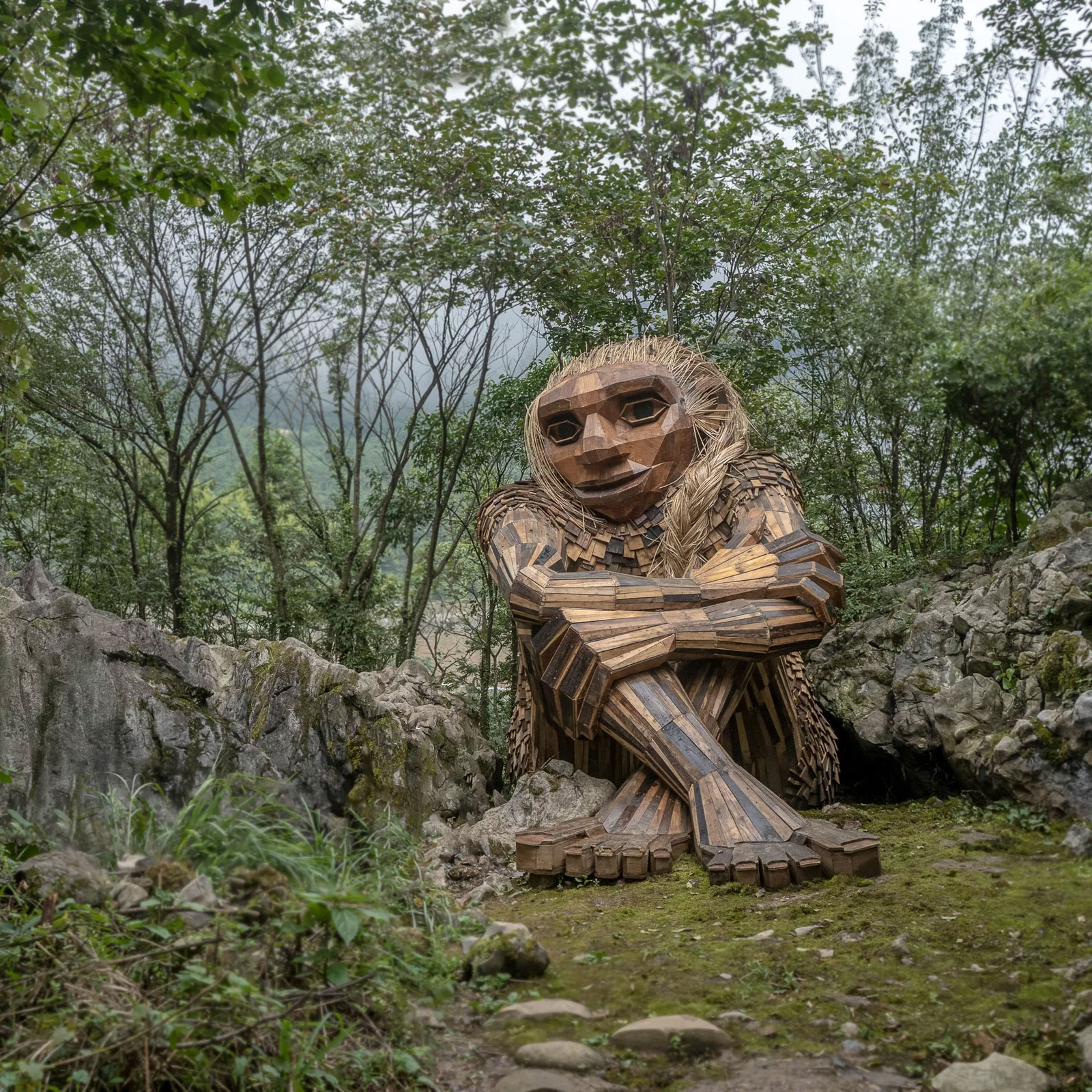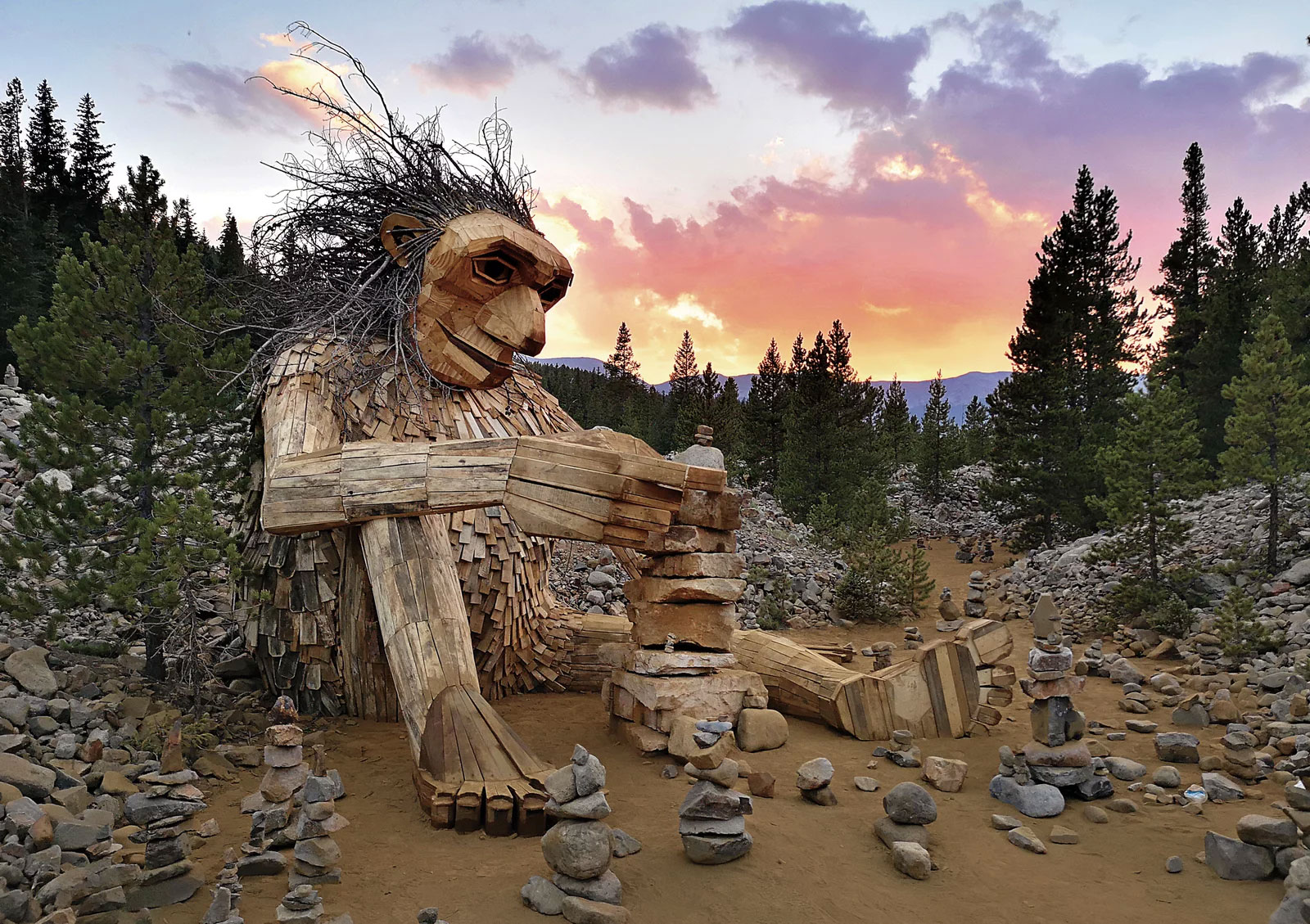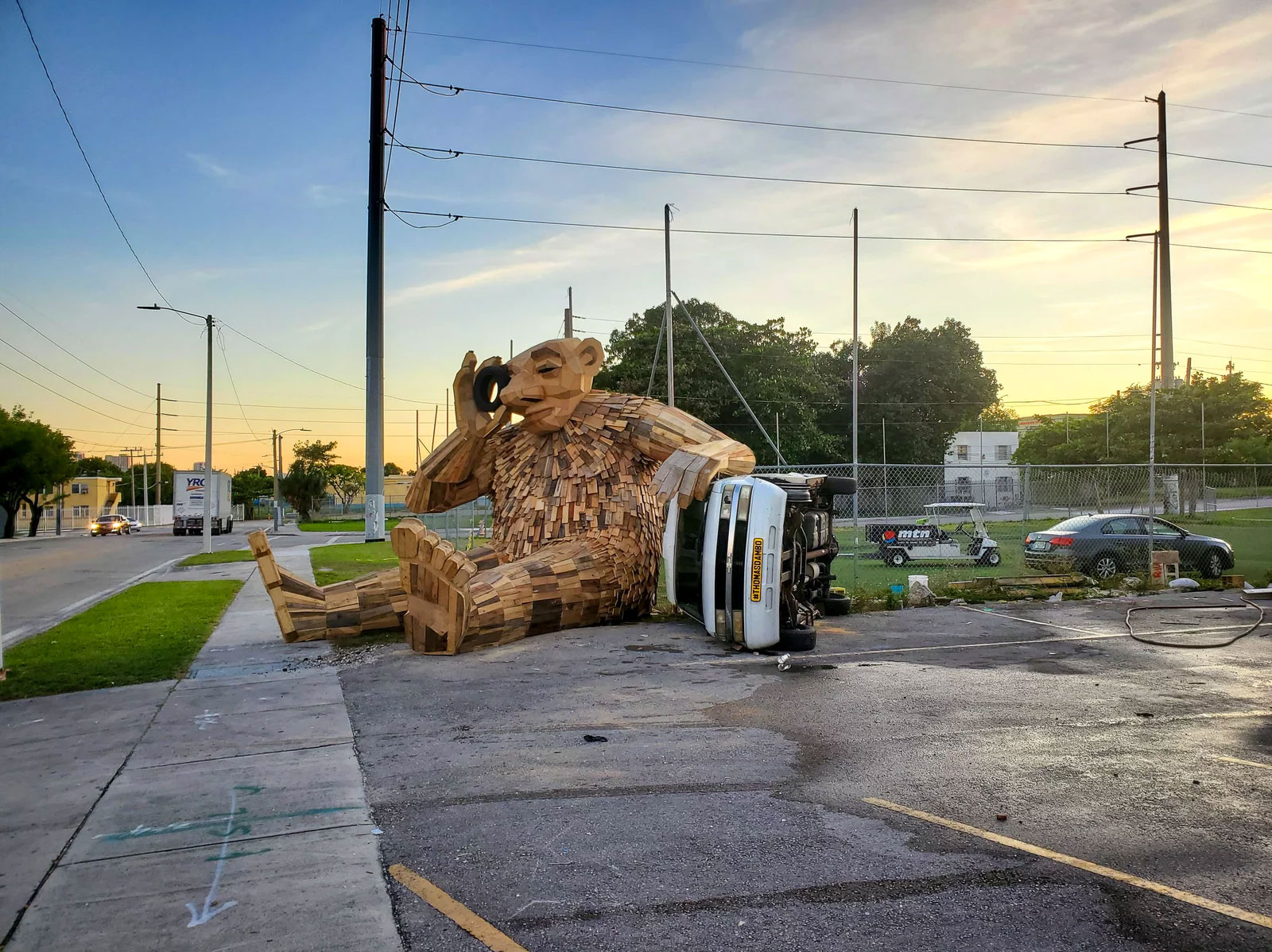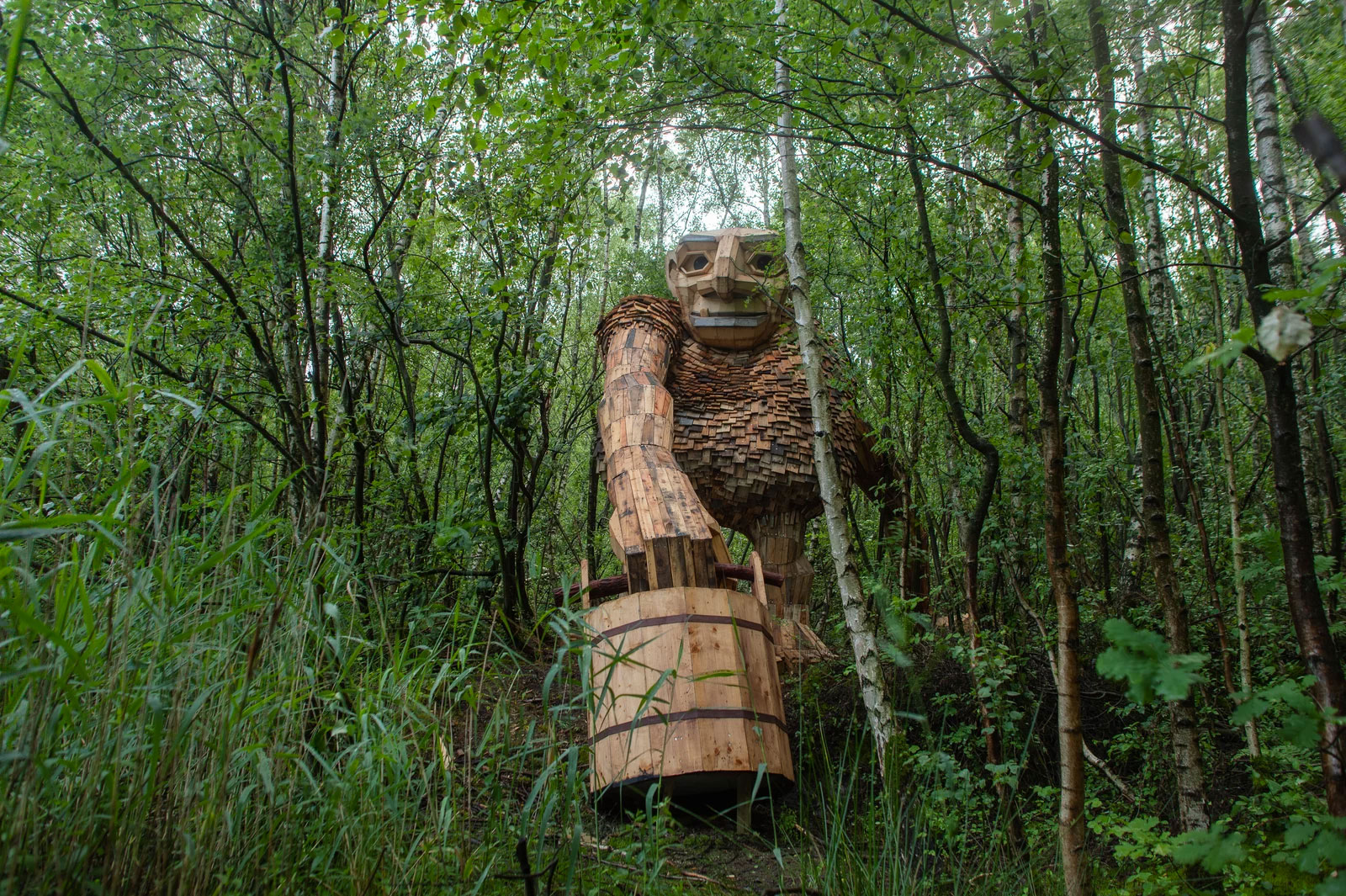 VIEW LARGER "Recycle art activist" Thomas Dambo makes gentle giants from scrap wood, old pallets, twigs and debris. Above, the troll Marit in It Sounded Like a Mountain Fell in Wulong, China.
VIEW LARGER "Recycle art activist" Thomas Dambo makes gentle giants from scrap wood, old pallets, twigs and debris. Above, the troll Marit in It Sounded Like a Mountain Fell in Wulong, China. On a recent day in the Maine woods, a small army of Geppettos in hoodies saws, drills and hammers away at the massive body of the "root troll," as Dambo refers to it. Standing on ladders or perched on the troll itself, they fasten hundreds of pieces of wood of various shapes and sizes onto an interior frame. The wood comes from all over: discarded shipping pallets from a hardware store, scraps from a nearby lumber yard and debris from fallen trees. Birk, as Dambo eventually names him, stands 30 feet high. His sprawling limbs stretch 30 feet wide. His feet alone are almost as tall as I am. Nearby, a massive pile of twigs and branches will be sculpted to form Birk's beard.
 VIEW LARGER This Dambo troll is part of the Guardians of the Seeds experience at the Coastal Maine Botanical Gardens.
VIEW LARGER This Dambo troll is part of the Guardians of the Seeds experience at the Coastal Maine Botanical Gardens. Dambo says each of the Maine trolls loosely resembles a different part of a tree: the roots, trunk, branches, leaves and flowers. He points out that Birk's skin is intentionally "bumpy" as he emerges from the soil. "A lot of my trolls, they have fur, but this one is naked," he says. "I'm imagining ... that this troll used to be underground and now it's pushed itself out of the ground," Dambo says, making the pushing gesture with his arms. "And that's why it has this naked skin feeling."
Dambo admits that the stories and concepts he comes up with might be lost on visitors. "It doesn't really matter for me," he says. What matters is that his trolls draw people into nature "to have a good experience there." He also hopes they see that garbage can be turned into something big and beautiful. "I like to think that my art can help change people's perspective from trash being something that has no value to something that has a big value," he says.
Dambo both designs the trolls and writes their fairy tales. "They're real to me," he says. "I know it sounds a bit crazy." Maybe. But the commissions have been pouring in. After he finishes the trolls in Maine, he'll make one in Jackson Hole, Wyo. This winter, he and his crew will travel to Australia and Asia. He says he gets so many offers that "some weeks ... we can't even open all of the mail."
 VIEW LARGER Creating giant trolls combines Dambo's passions for hidden adventures, Nordic fairy tales and recycling.
VIEW LARGER Creating giant trolls combines Dambo's passions for hidden adventures, Nordic fairy tales and recycling. Dambo, 41, is a former rapper with a playful, mischievous streak. As a student at Denmark's Design School Kolding, he got the idea to make birdhouses out of recycled wood for a project he called Happy City Birds. He has since made more than 3,000 of them. As a kid, "I would always crawl into the bushes. I would have to explore everything ... go off the beaten path all the time," he says. He and his mother spent hours scouring flea markets. She was a theater costume seamstress. His father was a blacksmith and then later fixed up old bicycles and sold them out of their basement. "My parents were definitely hippies," he laughs.
Dambo enlists local volunteers to help him and his team build the trolls. "Everybody wants to be a part of some big positive project," he says. But once he leaves, he can't control what happens to the trolls. That became dramatically clear with the gentle giant Isak Heartstone, a troll he designed for an arts festival in Breckenridge, Colo.
 VIEW LARGER Isak Heartstone, a troll in Breckenridge, Colo., was ultimately a victim of his own success — the Breckenridge Town Council voted to dismantle him after locals got fed up with the thousands of tourists coming for troll selfies.
VIEW LARGER Isak Heartstone, a troll in Breckenridge, Colo., was ultimately a victim of his own success — the Breckenridge Town Council voted to dismantle him after locals got fed up with the thousands of tourists coming for troll selfies. Drawing inspiration from Colorado's history of mining and mountaintop removal, Dambo created Isak Heartstone sitting on a hiking trail stacking rocks, almost like a giant toddler building a tower with blocks. Dambo says Isak was "trying to build a new little mountain because he's sad the other mountain has been broken down."
"What was special was just the sheer magnitude and beauty of it," says Haley Littleton, a spokesperson for the town of Breckenridge. "There was so much excitement around just how cool he was and how well he actually fit into our scenery and our environment," she says.
But too much of a good thing couldn't last. Isak Heartstone became so popular, Littleton says, that "thousands of visitors" started driving their cars or taking buses to get as close as possible and then hike in to take selfies with him. That led to "an issue with parking and trash and having to send our officers out there to sort of manage the parking situation and direct traffic," she says.
"I'm sitting back in Denmark and I'm like, 'Wow, this is crazy,' " remembers Dambo. "This bunch of pallets we found by the dump next to a hardware store or something ... we rearrange them and put some troll magic on it, and now it's like the big celebrity talk of the town."
Call it NIMBY troll. Residents in the nearby neighborhood complained about being overrun with tourists. In winter, some people slipped on the ice on their way to see Isak Heartstone. The Breckenridge Town Council ultimately voted: The troll had to go.
Dambo was incredulous. He notes that the neighbors who complained about having their privacy violated were once themselves nature's "intruders." As for fears about more people slipping on the ice, he says, "In Denmark, if you hike a mountain in the middle of winter, it's your own fault ... if you fall on the ice. ... People in Denmark would laugh at people who would try to sue somebody like that."
A construction crew tore Isak Heartstone down with chainsaws. To avoid an outcry from fans, Isak's demise was not publicized. "It was just such a crazy story, and I didn't know how to cope with it," Dambo remembers. In response, he and his friends wrote a reggae song about the episode called "Isak Heartstone Killed by the Government."
For Marion Hourdequin, a professor of philosophy and environmental science at Colorado College, the tale of Isak Heartstone is a little like the National Park Service grappling with nature being "loved to death." How do you get people into nature without destroying it? "Many public land managers are grappling with the question of how to enable those places to be accessible to people, to be enjoyed and appreciated, while also balancing that with the need to protect the other living beings there, the animals, plants and ecosystems," says Hourdequin.
Littleton concedes that Isak Heartstone taught Breckenridge an important lesson about public land art. "I think it really showed us the tension and paradox that is in all of that for us," she says. "We want to encourage people to get out on trails and we want to encourage an appreciation for the environment, but in a way that also protects it. That's something we've also seen during COVID: this rush of people wanting to get out and distance themselves in the mountains, but also seeing a huge increase in trash."
 VIEW LARGER Joen and the Giant Beetle at the Wynwood Walls outdoor museum in Miami.
VIEW LARGER Joen and the Giant Beetle at the Wynwood Walls outdoor museum in Miami. A few years ago, the Coastal Maine Botanical Gardens faced its own controversy when it embarked on an expansion project that included building a new visitors center. The Maine Department of Environmental Protection fined CMBG for construction projects that it found were in violation of the state's Natural Resources Protection Act.
When I asked Dambo whether there's a contradiction within efforts like his to raise eco-awareness but disrupt nature in the process, he takes a global perspective. He says what might seem like a serious violation of the environment in one community is "completely dwarfed" in another. Environmental concerns in Beijing, for example, are different from those in Breckenridge or Boothbay.
"When you fly into Beijing ... and you fly over a landscape that looks like Yosemite National Park but it's just high-rise residential buildings [that] just keeps going and going and going ... and then you come to another place and they argue over one little building — it seems so unimportant." But Dambo adds, "I think that everything needs to be really important where you are, because that's where you can fight your fight and that's where you can make the change."
Meanwhile, Breckenridge formed a "troll task force" to find Isak Heartstone a new home. Dambo returned to rebuild him. Now he even has his own trail.
It wasn't the first time Dambo traveled hundreds of miles to bring one of his trolls back to life. In 2014, Dambo created his very first troll, Hector the Protector, on the Puerto Rican island of Culebra. Hector sat on rocks at the water's edge, protecting the island. In his hand, he originally had a rock "ready to throw at invaders," smiles artist Mark Rivera, one of Dambo's collaborators. But Hector did not survive Hurricane Maria. Rivera says Culebra was particularly hard hit. In 2019, Dambo returned to the same spot to make Hector 2.0. Instead of a rock, he's now holding a lantern embedded with a solar panel so boats can see the coastline in a hurricane.
 VIEW LARGER Hector el Protector was originally built on the Puerto Rican island of Culebra in 2014. Hector was destroyed by Hurricane Maria in 2017 and was re-created — now holding up a lantern, as shown above — in 2019.
VIEW LARGER Hector el Protector was originally built on the Puerto Rican island of Culebra in 2014. Hector was destroyed by Hurricane Maria in 2017 and was re-created — now holding up a lantern, as shown above — in 2019. "He's really special," says Rivera, who first met Dambo in 2016 when he was building a troll for a street art festival near Rivera's home in Santurce, Puerto Rico. Charmed by what Rivera calls Dambo's "infinite ideas" and commitment to the communities where he builds his art, Rivera joined Dambo's crew and helped rebuild Hector 2.0.
"Thomas is beloved in Puerto Rico," says Rivera. "He came back and lifted people's spirits. He's not a doctor. He's an artist. So he uses his art to make people happy." Local schoolchildren made a necklace for the new Hector and wrote a song about him.
Back at the Coastal Maine Botanical Gardens, Daniel Ungier says Dambo's trolls "have this magical way of connecting people to nature and to telling a story about how we all have to do our part to take care of the landscape around us." Ungier, CMBG's director of education, adds that "the way Thomas built the story, the trolls have this kind of supernatural power, but they can't do it alone."
Dambo says he's always moved by people's emotional response to his sculptures. He also knows it helps that his trolls have become social media stars. He hopes that while people are taking their selfies, they also look around and discover the wonders of the world the trolls are protecting. "Why would people care about protecting nature if they are not connected to it and not reminded that it's there?" he asks. Leave it to giant trolls to lure them there.
 VIEW LARGER Mikil of The 7 Trolls and the Magical Tower in Boom, Belgium.
VIEW LARGER Mikil of The 7 Trolls and the Magical Tower in Boom, Belgium. 
By submitting your comments, you hereby give AZPM the right to post your comments and potentially use them in any other form of media operated by this institution.